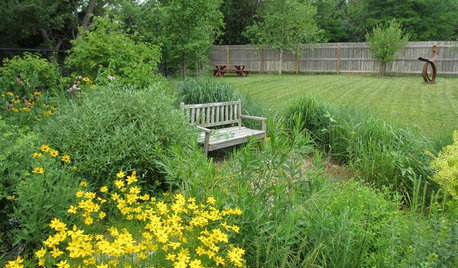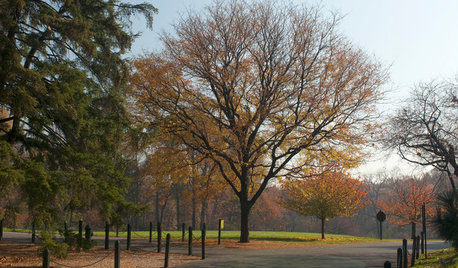orchard report
Peter 4a
8 years ago
Featured Answer
Sort by:Oldest
Comments (14)
prairie_northrose (3b north of Calgary AB, Canada)
8 years agolast modified: 8 years agowayne
8 years agoRelated Discussions
Reports on our Community Orchard
Comments (9)Sorry Kansasfruiter now I remember you from about a year ago. I had confused you with Kansasapple, which is guy who is occasionally on this forum and owns an orchard in Edgerton KS. Southwest KS has a pretty different climate than what we have here so I can't give you any specific advice. It's pretty dry and you may be able to get by with little or no spraying. My advice would be to have someone monitor for fruit pests once the trees start producing, and if needed develop a spray program at that time....See MoreReport from the Orchard
Comments (1)My home orchard of 17 assorted fruit trees is in 2 locations here in SE WI. My North Star cherry in my backyard has a good crop of cherries despite the numerous frosts we hd while in bloom. MY Reliance peach in my backyard has a light crop of peaches. 15 minutes away in the country is where the rest of my trees are at my brother-in-law's farm. A very open windy site. My peaches at this site were just covered with flowers yet due to heavy frost have just a handful of peaches on each. Same story on the Mesabi and Balaton cherries. The apples flowered but appear to be a total loss. I found one nice apple on the McIntosh but the rest of the appples have fruits that are yellowing up and dropping off. My only hope is that my Northern Spy might have fruit since it bloomed after most of the frosts (assuming it got pollinated). At least the grapes and raspberries seem to be ok! I think I will have something I can pick this year. Sad year to be growing fruit....See MoreOrchard Floor Research Report
Comments (18)"Agree with harvestman. That's a function of weeds shading the tomatoes." That's true, but I also suspect root competition may play a role. It goes back to the long standing debate on the forum about the effect of N on brix. In the past we've all posted lots studies regarding the relationship of brix and N. I don't think there ever was a consensus on the issue, in the studies or forum members. For my own part, I believe the correlation is best represented by a parabola (i.e too little N, or too much N reducing brix, while max brix is achieved with a moderate amount of N). I really don't want to start that debate again because I don't have time to Google up a bunch of studies again. Nevertheless, weeds do compete for N (and other nutrients - which also may lower brix) as well as their potential allelopathic competition, which I believe can have an effect on brix. A quick Google yields several studies of the detrimental effects of weeds on fruit crops, but most of these are w/ low growing crops (brambles, etc) so it can always be suggested the lower brix resulted from reduced light. I did come across one study (of Guava) which indicated a strong correlation (i.e. more weeds = lower brix). I don't know much about Guava, but the trees seem to be about the same size as peach trees, and the orchards seem to be spaced about the same as a peach orchard. However, even the study mentions not only do weeds compete for water and nutrients, but also for light (As I mentioned earlier, we chopped weeds last summer to keep them from growing up through the canopy here at the house.) So again, one could argue reduced brix from weeds is not a function of nutrient competition, but of light competition. An argument which can always be made because just about all commercial fruits are grown low enough to the ground to be affected, at some level, by light competition from weeds But again, my opinion is that reduced brix is a function of both (light and nutrient competition). Here is a link that might be useful: Effect of herbicides and hand weeding on weed control in Guava...See Morewillis orchards nailed, dead trees for sale!
Comments (0)In late July, while driving home from my summer vacation in Florida I decided to go out of my way to drive to Berlin Ga and visit Willis Orchards- hardly an orchard! Their tree website was very attractive and had several fruit trees that were offered for sale for my zone in Mass. The nursery was located back in the boondocks and really hard for me to find, I was surprised that it was so small, considering their dominating presence on the internet. Most of the stock looked like left-over fruit trees that they didn't sell this year and lined out in withered rows of trees that were secured inside chain linked fences. The most surprising thing was seeing so many dead trees that were standing there, many trees with both green leaves and brown leaves. If I owned that nursery I would clean up the thousands of weeds growing six feet high around all the trees. It seems to me that leaving all those dead and infected trees with the other semi healthy ones, would make them sick too! I'm glad I did not order any plants for fall shipping because if the same plants I saw are the ones Willis is selling I don't want them anymore. I did buy a few banana plants that looked like yellowing banana nubs, but I have since planted them and even though they have not grown yet, they promise me they will. The banana trees were cheap enough, though. I will report later as to how the bananas do. I know I wont be wasting my time or money driving to Berlin again....See Moresandbur2
8 years agoPeter 4a
8 years agoPeter 4a
7 years agomattpf (zone4)
7 years agolast modified: 7 years agoGreg- Brandon, Manitoba. Zone 3a
7 years agomattpf (zone4)
7 years agoGreg- Brandon, Manitoba. Zone 3a
7 years agoKonrad..just outside of Edmonton Alberta
7 years agoGreg- Brandon, Manitoba. Zone 3a
7 years agoKonrad..just outside of Edmonton Alberta
7 years agolast modified: 7 years agoGreg- Brandon, Manitoba. Zone 3a
7 years agolast modified: 7 years ago
Related Stories

CONTRACTOR TIPSBuilding Permits: When a Permit Is Required and When It's Not
In this article, the first in a series exploring permit processes and requirements, learn why and when you might need one
Full Story
GARDENING GUIDESHow to Design a Garden That Lasts
Climates are changing. Wildlife is evolving. Can your garden keep up?
Full Story
GARDENING GUIDESTop 12 Summer-Blooming Perennials for Deer-Resistant Drama
Can you have garden color, fragrance and exciting foliage with hungry deer afoot? These beauties say yes
Full Story
EARTH DAYGrow a Beautiful Garden With Ecofriendly Greywater
Reducing home water waste means lower bills and a healthier planet. Here's how to set up a greywater home irrigation system that can help
Full Story
LIFEHard Winter? 9 Ways to Battle Cabin Fever
We know a lot of you are trapped where it just won’t stop snowing. Here are some ways to survive
Full Story
LIFEHow to Decide on a New Town
These considerations will help you evaluate a region and a neighborhood, so you can make the right move
Full Story
EARTH DAYHow to Design a Garden for Native Bees
Create a garden that not only looks beautiful but also nurtures native bees — and helps other wildlife in the process
Full Story
LANDSCAPE DESIGN15 Great Ideas for a Lawn-Free Yard
End the turf war for good with hardscaping, native grasses and ground covers that save water and are easier to maintain
Full Story
GARDENING GUIDESGreat Garden Combo: 3 Wonderful Plants for a Deer-Resistant Screen
Protect your privacy and keep deer at bay with a planting trio that turns a problem garden area into a highlight
Full Story
EDIBLE GARDENSGarden BFFs? Why Your Vegetables Are Begging for Companion Plants
Foster friendships among plants for protection from pests, pollination support and color camaraderie
Full Story


ubro